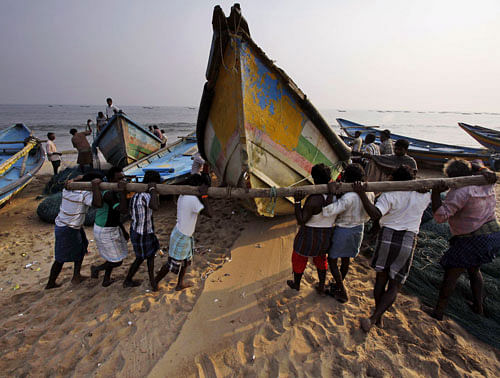
Combining real-time data with science, technology and social media, ‘Radio Monsoon’ to boost safe fishing
How about a system that sources real-time information on weather from GPS-equipped fishermen at sea, processes this vital data through scientists and researchers, and disseminates it quickly to the fishing community via mobile phones, radio and the internet?
A pilot project by a network of private and public institutions, with technological input from Bangalore has now shown that this is an eminently workable idea.
It’s called the Radio Monsoon, where fishermen talk waves! Simply put, this is what the project does, as explained by the brains behind it: “For a traditional fisherman on a small boat or a canoe, the state of the sea and the sky makes all the difference – fish or no fish, safety or risk to life.
To contribute to safe and better fishing, we disseminate regular forecasts on weather, wind, waves, currents, and fishing zones.” The medium used: small loudspeakers on the coast, over the Internet, by word of mouth or through a free phone number.
Listening to fishermen
But this is a two-way process. “We listen to the fishers – what their own forecast is, what is it like out there in the sea when they go to fish everyday. We try to spot where these responses are coming from using the fishers’ own GPS sets. We process and give this feedback to the scientists – making a regular two way communication possible.”
The tech team in Bangalore is currently trying out an innovative, interactive platform to make the communication even simpler. Explained the team lead, Shruthi S., “We fit iPhones with a professional field reporting software, a set of specialist microphones, and wind shields for use on the windy coast. Our field reporter/s use this gadget to record the views of the fisherfolk in our test site and pass it on to our studio in Thiruvananthapuram.”
The programmes are made in the studio and transferred to the Bangalore hub - for further dissemination. “We upload it in SoundCloud and to a dedicated server at Gramvaani, an IIT Delhi-based start-up. Now the fisherfolk can straightaway dial up the free phone number of the server, leave a missed call and get weather info, anytime they want.”
This was tested successfully and demonstrated recently at a workshop in Indian National Centre for Ocean Information Services (INCOIS).
Processed data
At the village -- Vizhinjam in Thiruvananthapuram was chosen for the pilot--, Radio Monsoon plays the narrowcasts downloaded from the server over mobile phones. This is amplified by portable speakers linked by Bluetooth. The tech interface for this is tested and tweaked in Bangalore.
The next step, as Shruthi informed, is to enable social media updates by the fisherfolk themselves.
“It could be Whatsapp, Twitter....even Facebook. We need to test on the ground first.”Once the six-month pilot is completed, the project intends to broadcast real-time relevant radio programmes over All India Radio.
A trained team of reporters / producers will be aided to set up their own community initiative. The project’s success is bound to be propel duplication in the coastal belt of Karnataka.
Besides INCOIS and Gramvaani, the project has data, technology and consultation support from the India Meteorological Department (IMD), the climate migration research group of the University of Sussex and a climate-knowledge sharing initiative supported by the Sussex Innovation Centre.